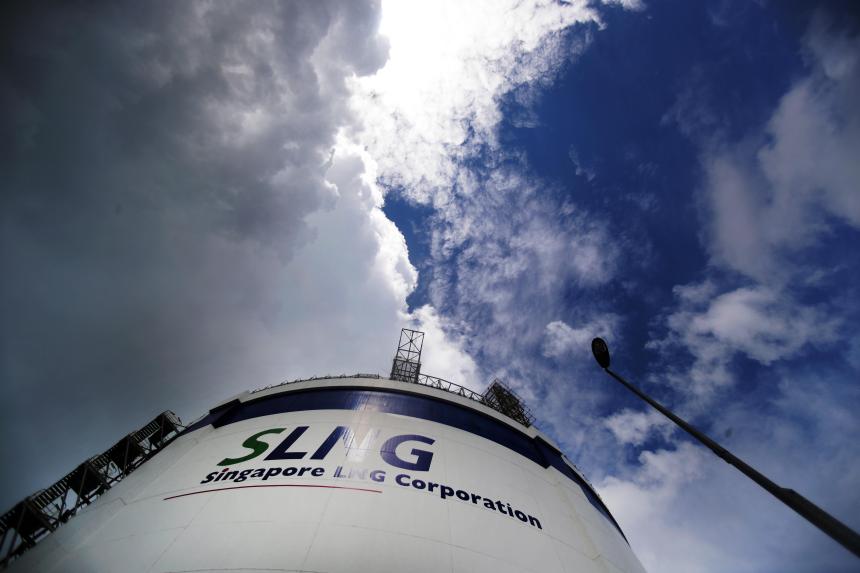SINGAPORE - Singapore continues to welcome global energy traders, including liquefied natural gas (LNG) players, to set up operations here even as it doubles down on efforts to decarbonise and meet its goals to tackle climate change, Second Minister for Trade and Industry Tan See Leng said on Tuesday.
He added that the Republic takes a pragmatic approach to the energy transition and believes that natural gas will continue to serve as a reliable source of energy until fully replaced by carbon-free fuels such as hydrogen.
Dr Tan, who was speaking at the opening ceremony of the Gastech 2023 conference, said that without natural gas, it would be challenging for many countries to achieve the dual objective of energy security and decarbonisation. “That is why we have continued to facilitate the growth of the natural gas sector within Singapore, and encouraged leading international traders to anchor your activities here,” he said.
Natural gas plays an important role in Singapore’s energy mix – it powers around 95 per cent of the country’s electricity supply. Most of it is piped from Malaysia and Indonesia, but an increasing amount is now being shipped in liquefied form from places as far as the United States, Qatar and Australia.
Other sources of power generation – including solar, biomass and municipal waste – accounted for 2.9 per cent, followed by coal at 1.2 per cent and petroleum products such as diesel and fuel oil at 1 per cent, according to Singapore’s Energy Market Authority (EMA).
Gas-fired power generation has also picked up in many other countries worldwide, doubling the volume of global LNG trade between 2015 and 2022. Dr Tan said natural gas consumption in the Asia-Pacific region is expected to double to more than 1,600 billion cubic m by 2050, from 2020 levels. South-east Asia is expected to become a net gas importer by 2025 as natural gas demand exceeds production.
Hence, Singapore has been investing in a strong LNG ecosystem, establishing itself as a leading LNG trading and bunkering hub in Asia.
A total of 60 LNG traders operate in Singapore, including the world’s top 10 global energy traders. In 2022, about US$240 billion (S$327 billion) worth of LNG trade flowed through Singapore – equivalent in value to about 50 per cent of Singapore’s gross domestic product.
Singapore’s LNG terminal, operated by SLNG Corporation, had begun operations in 2013 with a throughput capacity of 3.5 million tonnes per annum (mtpa) but can now handle up to 9.6 mtpa.
Dr Tan, who is also Manpower Minister, said: “We are studying the need to further expand our LNG infrastructure, given domestic electricity demand growth and regional trade flows of gas.”
While these investments would add significantly to Singapore’s capabilities in the LNG value chain, the country also needs to invest in building a strong core of local LNG trading professionals, he said.
“With that in mind, Enterprise Singapore launched the Leadership Development Initiative for LNG trading,” he said, adding that major oil and gas companies such as Chevron and TotalEnergies have joined the programme.
But ensuring energy security need not be incompatible with Singapore’s climate goals, Dr Tan said. Therefore, Singapore – which is committed to achieving net-zero emissions by 2050 – has taken many initiatives to decarbonise the natural gas value chain.
“We have embarked on measures to reduce greenhouse gas emissions, such as upstream flaring mitigation, methane slip reduction, and electrification of production and liquefaction infrastructure.”
For example, the Government is working with industry partners to explore the use of carbon capture, utilisation and storage technologies to reduce the carbon footprint of natural gas.
“We are also supporting the development of low-carbon and renewable gases, such as hydrogen and biogas. These can be blended with natural gas to reduce the emissions generated, or be used as alternatives in the future,” said Dr Tan.
EMA is proposing to require all new and repowered power-generation units to be at least 30 per cent hydrogen-compatible, with the ability to be retrofitted to become operationally 100 per cent hydrogen-compatible in the future, he added.
SLNG is also studying different potential applications of harnessing the cold energy from LNG regasification. For example, it is collaborating with Linde Gas, a leading global industrial gases and engineering company, to use the cold energy to liquefy carbon dioxide (CO2).
“If feasible, this could become the first carbon dioxide liquefaction facility in Singapore and the region, allowing for the capture of CO2 which may otherwise be emitted into the atmosphere,” Dr Tan said.
He said EnterpriseSG is working with US oil giant Chevron and Singapore’s Pavilion Energy to explore the possibility of developing a Singapore standard for carbon-accounted LNG to calculate greenhouse gas emissions from LNG trades.
Gastech 2023 is one of the world’s largest conferences for LNG, and the low-carbon solution and climate technology industries. About 4,000 delegates are expected to attend 116 sessions at the four-day conference at the Singapore Expo that will feature around 500 speakers.


